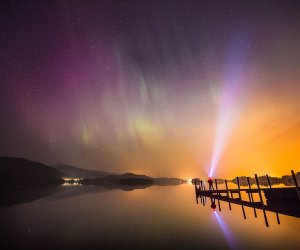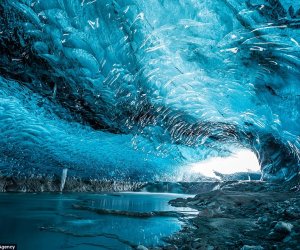Sensational light shows wow crowds across the globe

Solar storm was caused by two blasts of magnetic plasma that left the sun on Sunday and hit the Earth last night
Classified as severe, it ranked 4 on National Oceanic and Atmospheric Administration's geometric effects scale
Experts said it is the strongest solar storm to blast Earth since autumn 2013 and it was expected to be a level 1
Auroras caused by the storm were first seen in the northern tier of the US including Washington and Wisconsin
Dramatic light shows were then spotted across the UK, into Ireland and as far south as Germany in Europe
Parts of Australia and New Zealand were also treated to the display - known in this hemisphere as Aurora Australis
Global displays were more widespread and vivid than those caused by a solar storm in February
A severe solar storm blasted into Earth last night causing stunning displays of aurora to be spotted in some of the far corners of the globe.
Amateur and professional stargazers alike were wowed by the Aurora Borealis and Aurora Australis across the northern and southern hemispheres including the UK, as far south as Germany and a blanket across Australia and New Zealand.
And these breathtaking displays ranged from the iconic green - which tied in nicely with St Patrick's Day - to rare vivid pinks and purples as particles collided in the atmosphere.
An expert in Australia described the Australis event as the 'best aurora displays in years.'
And while it wasn't the 'biggest' event recorded, the Bureau of Meteorology's Matthew Francis said it was one of the most significant in the sun's current 11-year cycle of activity.
'We've probably had a dozen or so over the last few years that have been quite good shows for the Tasmanian aurora watchers, but this is definitely one of the best,' said Mr Francis.
'There's a few things that have to line up for us to get one of these events. In this case, it was quite a strong event, so a lot of energy was deposited and further out from the poles.
'The further away that it's visible from the pole is indicative of a bigger and stronger event.'
Countries such as Finland and Norway, for example, are closer to the magnetic north pole than Tasmania is to the south pole.
In Wales, landscape photographer Anthony Pease, from Llandovery, Dyfed took his son Harri to see the displays.
'Harri is only four days old. He's already seen his first Aurora and he's got a solar eclipse coming up on Friday - not bad for his first week!' said Mr Pease.
'When you see them in the UK, they're usually very low on the horizon as you're seeing them from a long way off, taking place in the skies over the northern hemisphere or, sometimes, Scotland.
'The forecasts for Tuesday were unusually good and it looked like it was shaping up to be a once-in-a-lifetime chance.'
Mr Pease spent the day working on commission on Pen-y-Fan in the Brecon Beacons.
'It was an incredibly clear night and the aurora was particularly strong, suggesting they were probably taking place over Scotland. Opportunities like that don't come along very often - I'm thrilled I took Harri along for the show!'
Meanwhile in Canada, a Twitter user wrote: 'I've probably jumped a dozen times out of shear excitement' and another in Newcastle said 'Last night was amazing, standing in my garden the whole place lit up pink even through the clouds. That was with light pollution.'
(dailymail.co.uk)
ANN.Az








Similar news
Similar news




































 Photo
Photo 



 Video
Video 

